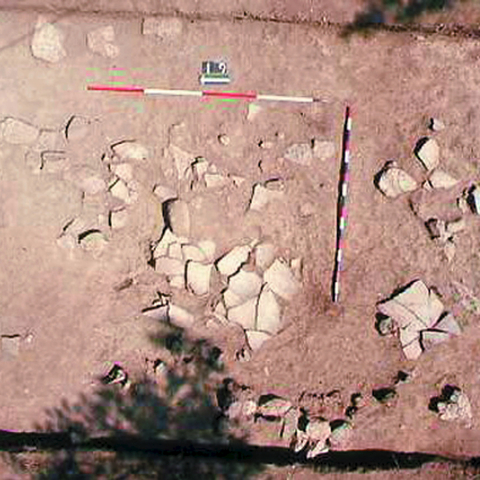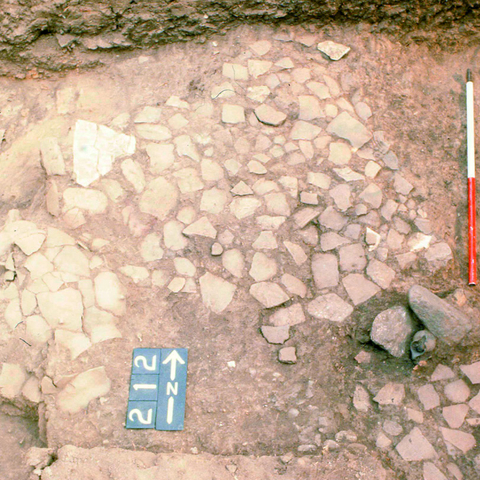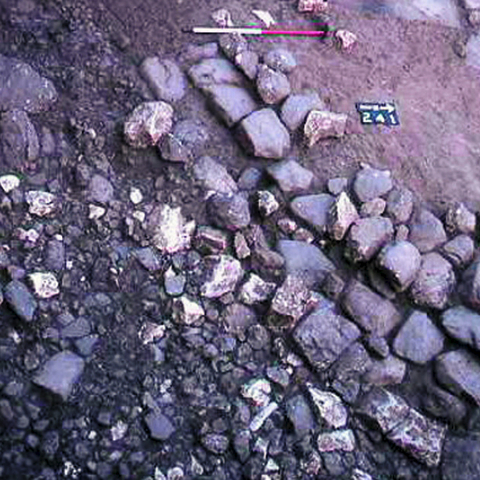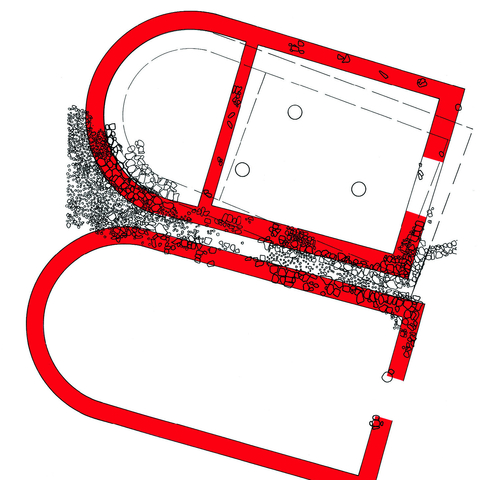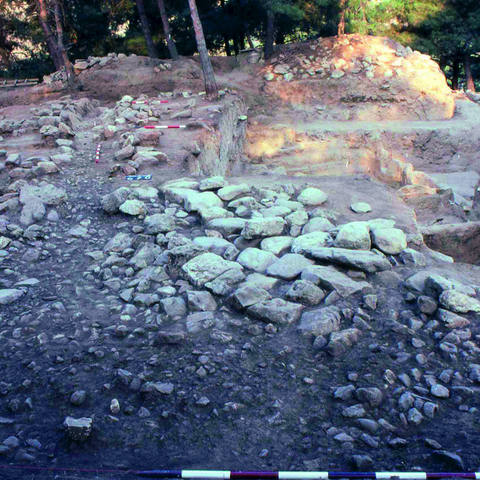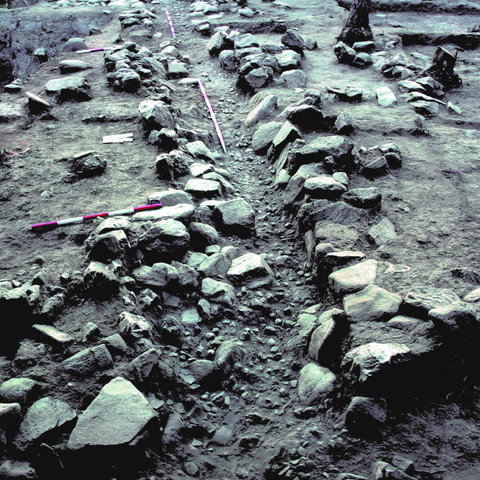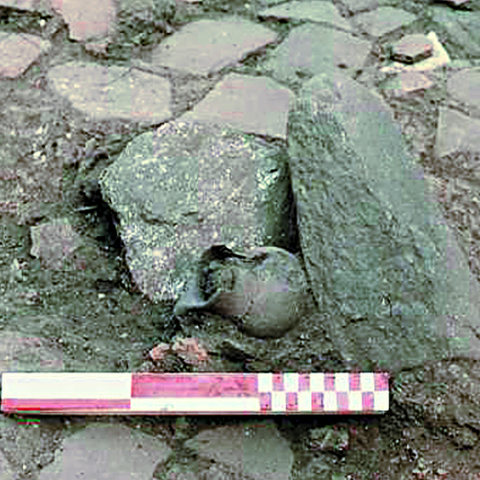The structure and finds
Northern area
The narrow trench at the west of this area uncovered a length of wall, a single course high and probably two wide, which seemed to form the corner of a building lying further to the west, with a few stones, probably fallen, to the east of it. Finds from the area around the stones included three spindle whorls and a chert flake. These finds presumably represent a yard surface. In the north east corner of the Toumba a scatter of stones and sherds marks a similar level which was perhaps part of the same open space. Finds from this area included a small cut-away-neck jug (P244), two spindle whorls, a fragment of stone pot lid and two joining pieces of worked stone. Other finds included a quern stone, an almost complete whetstone and a piece of chert resembling a threshing insert. Modern civil war disturbance was suggested by two spent cartridge cases while a live one was found in the topsoil.
The northwestern area
The Phase 1 stratum was found at a lower level on the west of the Toumba than towards the centre, because of the slope of the underlying Phase 2 buildings. Here it was less compacted than elsewhere and the original surface of occupation was indicated by only a few scattered groups of stones, except for a short length of rough stone wall, two courses high and approximately two courses wide. The finds from this open area are a typical mixture of complete and fragmentary objects with no obvious concentrations. They include much of a coarse two handled jar, three spindle whorls, two and a half sherd discs, two fragments of stone pot lids, a piece of a whetstone and of a stone axe, and a fragment of a robust bone awl. The only complete vessel was a miniature coarse pot.
The northern yard
The brown earth was deeper (up to 40 cm) and more compacted in the west of this area than elsewhere. It sloped down from east to west where an irregular row of stones, running north south, indicated a rough (or disturbed) terrace wall with a drop to the west. A second ʻrowʼ of stones was found at a higher level, suggesting a rebuild, while to the east of it scatters of stones and sherds on two different levels indicated an open area with two phases of activity. In approximately the centre of the area, a roughly rectangular enclosure of small stones belonged to the upper level. The western edge was well defined, but not the eastern. Measuring c. 3.5 m north-south and 1.5 m east-west, it at first suggested the outline of a burial pit, an impression reinforced by the discovery of a bronze pin with a flat disc head (SF 1208) within the rectangle at the same level[54]. Careful examination of the area revealed no sign of any pit, however, nor any bones or objects at a deeper level which might have belonged to a grave. If the rectangle is supposed to have marked the base of a totally eroded grave pit, we have to assume an eroded depth of 50-75 cm on the highest part of the Toumba, which seems rather improbable. No other clue was provided for the function of this structure.
Further east the deposit was thinner. Here there was little sign of the two levels and relatively few stones. The open area was limited to the east by fragments of stone wall belonging to the structures in the north east of the mound. In the south, towards the walls of the apsidal building, the sherd and stone scatter was rather denser and in places helped to define the outer edge of the robbed-out wall.
Finds from the lower level (where it could be identified separately) included one and a half spindle whorls, two fragments of stone pot lid, two fragmentary bone points, a piece of worked chert and one of the rare manufactured pierced clay disc. A similar assortment of oddments came from the upper level: a large portion of a shallow bowl with two horizontal handles (P175), a large part half a stone pot lid, five whole and two fragmentary spindle whorls, two sherd discs and a fragment of another, a pierced stone object and a chert tool. Metal finds included a coil of bronze wire and a fragment, a complete iron ring of uncertain date and a modern cartridge case. Objects from the topsoil included half a spindle whorl, a fragment of pot lid and a rubbing stone.
The northeastern area
The area to the north east of the apsidal buildings may have contained some structures, to judge by the fragments of stone walls and the smashed pithoi, in addition to scattered stones (Fig. 3). Only one level was found in this area, either because the structures were erected as the same time as the first apsidal building and remained unaltered, or because later disturbance, root action etc., had removed any traces of the division. The walls appear to have three different alignments and do not suggest a coherent plan for the area, but may have been out-houses or animal sheds erected in a haphazard manner as required.
In the north were two short lengths of north-south wall, a single course in height and formed of small rough stones to a width of no more than 30 cm. Six metres to the east a pithos had been set in the floor but beyond this the stratum petered out towards the Toumba edge. Further south were three more fragments of stone wall, one course high and between 30 and 40 cm wide. Two met at a right angle, while the third, a little to the south west, could once have formed another right angle. All were oriented about 30o away from the alignment of the group to the north west. Immediately to the south east of these walls was a spread of pithos sherds perhaps from a pithos which had once stood in the corner, while a second scatter some 2 m further south included a base. To the south and east the scatter of sherds and stones became less dense, with a short length of wall with yet another alignment and the neck of a pithos.
Clay finds included seven spindle whorls and a fragment, a bead, five complete sherd discs, three halves and two fragments, most of a manufactured disc with two holes and a piece of a pierced object as well as a loomweight fragment and a coarse miniature vessel. There was a single piece of worked bone, a possible whetstone, and another worked stone as well as most of two querns and fragments of two pot lids. There were no large fragments of pottery vessels apart from the pithoi.
The northern apsidal building
The first traces of this building were found in 1977 when floor levels of pebbles and sherds, pithoi shattered on the floor, and the stones of the curved walls which formed its south east corner[55] were found (Fig. 4 & Fig. 5). However, it was only with the discovery of the south wall and south west corner nine years later that it became apparent that these were the remains of a large two-roomed apsidal building measuring nearly fifteen metres in length from east to west and over eight north to south (Fig. 6). These remains however were scanty since erosion and stone robbing over two and a half thousand years have taken their toll.
Once the walls were exposed it was obvious that there were two phases of wall construction (as well as two successive floor levels within the building), though not until the last section of the wall was dismantled was it apparent which was the earlier wall and which the later. When the building was rebuilt and a second similar one added to the south, the orientation of the south wall was changed by about 8o, so that while the new south west corner was above and to the north of the older wall, the surviving stones of the new south east corner were lower and to the south of the older wall. The evidence for the order of construction, when it was at last found, was clear: in the east the south wall rested on the pavement which ran up to the north wall. Here it had been robbed away, to reveal the stones of the lower pavement running up to the earlier wall.
The only other place where evidence for both phases was preserved was in the cross wall closing the apse. The earlier wall, though robbed out when the later was built, was marked by the straight edge of the sherd pavement which had run up to it (Fig. 4) The later wall showed up as a rough alignment of larger stones, insufficiently preserved to allow us to be sure that the alignment of the whole building had changed, even though this is likely.
Of the whole stretch of the north wall, only four groups of large stones survive to indicate its line, and even these would be uncertain if they did not fit so neatly into the building as predicted from the external radius of the apse. The north west corner and much of the west wall is missing, but indicated by the edge of the sherd and pebble scatter. Only two and a half metres of the west wall survive. Here, the external faces of both the earlier and later walls are preserved, usually two courses in height and made with rough stones tightly packed together. In places there were irregular lumps of quartz, a type of stone not used in any other period for construction at Assiros. The inside wall faces are not clear and there was no attempt to prepare a foundation below floor level. The width of the wall is about 50 cm.
The south wall, as already mentioned, is the best preserved (Figs. 7&8), though even this is missing for part of its length in the centre, where only a few isolated stones of the earlier phase survive to show its alignment. The external face is irregular, because what survives is mainly the footing course built alongside the alley which separates the two buildings. Except for the south east part of the apse, the position of the internal face and the width of the wall can only be conjectural. Here large, relatively smooth stones had been carefully laid to form a firm base 90 cm wide which served for both walls. The building was constructed on a slope, presumably that of the ruins of the underlying Phase 2 and 1.5 structure so that the uppermost stones of the new wall in the east were nearly one metre higher than in the west. The floor of the earlier building may have sloped even more.
The cross wall of the apse divided the building into a main room with an internal length of 8 m and an apsidal room slightly longer (5 m) than the radius of the apse itself. In the earlier phase the wall had a width of 50 cm, to judge by the gap in the floor where it had been robbed out, while in the later only four groups of stones mark its course. There is nothing to show where the entrance was.
Nowhere do the stones of the walls stand more than 25 cm above the internal floor level, and the nature of the upper structure is a matter for debate. The dark brown earth, which was more than usually compacted in the area of these two buildings, was very difficult to break up and usually ended up as small lumps too large to pass through a 2 cm sieve mesh. Occasionally these lumps bore impressions of small branches, and sometimes had been reddened by fire. It is likely that at least the roof, and probably a large part of the later building, was constructed of clay-plastered branches. Although a careful search was made, no convincing post pits were found in the underlying levels which could have held the upright timbers needed for such a construction, or indeed for roof supports in the main room where a span of 8 m would otherwise have been needed. One possibility is that the stone walls were no more than low bearing walls for horizontal wooden beams into which the timber uprights were set. Some of the extra stones found beside the south wall may indicate the position of timbers of this kind.
Considering the size of this apsidal building, the remains of its walls seem very insubstantial. There was no heavily burnt destruction debris within the building and no charred wood to indicate the size of the main timbers.
Later disturbance has obviously penetrated the floors in many places since no continuous surface was found, but only small patches of fire- hardened clay or areas of laid pebbles or sherds, together with several shattered pithoi. For the same reason it was often impossible to distinguish the upper and lower floors or to be sure which patches of floor belonged to the earlier and which to the later building. As the floor in the main room alone sloped by over 50 cm from east to west, and the two floors were only separated by 10-15 cm, it is not surprising that this should be the case. The best preserved section of floor was in the north east corner of the main room, where a stretch of nearly 2 m of sherd and pebble pavement was preserved against the line of the robbed out cross wall (Fig. 4). Over this was a rougher surface principally formed of whitish stones. A pithos had been set in the floor against the west edge of the pavement. Another area of cobbled surface was found below a second pithos smashed in the centre of the west end of the room, where an entrance might be expected. Against the centre of the south wall was a hard patch of fire-reddened clay which perhaps represents a hearth area in the later floor, but close beside it was a group of small stones of an underlying wall which must have stood proud of the floor surface.
Because of the disturbed nature of the deposit and the lack of continuous floor levels some finds have been assigned to one floor level or the other on the grounds of the depth at which they were found. Nine vases were found at the level of the lower floor, either complete or sufficiently preserved to suggest they should be associated with the final use of the first apsidal building. Four of these were found in the north east corner of the main room and should probably be associated with the pavement in that area. These include a large handleless storage jar in fine ware with four rudimentary lugs on the shoulder (P177) and a small burnished one with incised decoration (P163 - in situ) a coarse one-handled jar (P390) and a plain cut-away-neck jug (P380). The others, which were scattered more or less at random, included a coarse miniature vessel (P151) and a small cut-away-neck jug (P150), found close together, as well as another coarse miniature vessel (P191) and a small one-handled jar with a lug (P422), and a cut-away-neck-jug with twisted handle (P226).
Other objects which certainly came from the lower level in the main room include, two spindle whorls, a loomweight fragment, and a stone pot lid. The only objects whose position may be significant were a group of pot handles, lying as if they were strung together when they fell to the floor, which may have served as loomweights in the same way as supposed for those found in the cupboards in Phase 2 Room 5. These were found about a metre from the wall in the south east corner of the main room.
Three pithoi had been set in the upper floor in different parts of the main room, and large parts of seven vases were recovered from the upper level which were probably in the room before the walls were robbed out (Fig. 9). These were a cut-away-neck-jug with twisted handle (P165) found with the shattered pithos in the west of the room, three more cut-away- neck jugs near the west (P154) and north (P153, P377) walls, as well as a fine ware jar with slashes around the shoulder (P152), part of a bowl with horizontal handles (P228) and a miniature vessel (P374). Other objects from the upper level were a spindle whorl, a complete sherd disc, a fragment of stone pot lid and a piece of worked antler.
Only one floor was preserved in the apsidal end. No pithos was found set in the floor though pithos sherds were numerous. Large pieces of a wishbone- handled bowl (P193) probably represent a vessel in use, while a body sherd with an exaggerated conical knob (P204) and a fragment of a funnel (P382) like the complete one from Phase 2 Room 13[56] came from the same area. Other finds included one plain and two decorated spindle whorls, as well as an unusual wheel-shaped one, a fragment of a large carefully pierced stone disc which could have served as the ʻflywheelʼ for a potter's wheel, most of a pierced stone disc, half a pierced sherd disc and a fragmentary bone point. Another pot lid fragment was incorporated in the floor.
Sherds from small fine ware bowls, often with wishbone handles, were frequent in the fill associated with both buildings but no example other than P193 was beyond doubt in situ. Large fragments of pottery included a wishbone-handled bowl with peak on the rim (P350) and two fine ware jars (P331, P345).
Other finds from the immediate area of the building, include two half sherd discs, an almost complete bone spatula and two fragments of worked bone, a stone pot lid fragment, a chert blade and a fragment of iron nail. A modern thimble, and a rubbing stone were found in the topsoil in this area.
A neat stone wall was found abutting the west wall of the earlier apsidal building at an angle of about 45o. It was set at a slightly lower level and enclosed a small area of trodden floor surface, which also had two phases. Presumably it represents an addition to this end of the building, perhaps a storeroom. There were pithos sherds on the lower floor, but no other finds of special interest.
The cobbled yard and the alley
At the same time as the first of the north apsidal buildings was constructed, a cobbled pavement was laid to the south and east (Figs. 5&7). Formed with relatively small stones, it incorporated large amounts of sherd. In places this surface clearly underlay the walls of the south apsidal building and the new north one, but elsewhere the new construction had disturbed it and it did not form a continuous surface. An area of cobbling found within the apse of the south building may be part of this surface, rather than of an internal floor, but it is impossible to be certain. The pavement was removed when the northern building was constructed but the cobbling was certainly patched and renewed on many separate occasions, while bone and sherd and other debris collected on its surface in large quantities. Excavation ceased a metre to the east of the building so we do not know how far these cobbled pavements may have extended. They were not found to the north east in the first season of excavation and may not have extended very far from the building.
Only the latest pavement surface could be traced the whole length of the alley which by now also served as a drain gully between the two apsidal buildings (Fig. 7 & Fig. 8). It was set below the level of the walls and sloped even more steeply from the open area in the east to the end of the south building in the west. At the west end it sloped away even more sharply and seems to have been laid on a surface which cut away the underlying destruction levels of Phase 1.5 and 2. At the very edge of the trench it was difficult to separate the stones of the pavement from those of walls below and it seems to have petered out in this direction.
Finds from the make up of the lower floor included a spindle whorl, a partly pierced sherd disc, half a pierced stone disc and a chert flake. Stone objects found between the pavements and from the make up of the upper one included a broken mould, a fragment of whetstone, an axe and a piece of a rubber. A fragment of bronze pin is probably ancient, while a Turkish pipe end is clearly intrusive. In addition to the usual range of clay objects, a pierced weight or pendant, a spindle whorl, and half a sherd disc, there were two fragments of what seems to be the pierced floor of some kind of kiln, though the nearest parallel known to me for the thickness of the pieces and arrangement of the holes is to be found in the curious Late Bronze Age cooking stands of found at Thermon[57]. Another curious item was a leg fragment from some kind of tripod bowl (P454).
Finds from the surface of the upper pavement or immediately above included two spindle whorls, a sherd disc with double piercing, a piece of stone pot lid, a chert flake, and a lead pot-mend. The function of a bananashaped clay object is uncertain while the 1966 drachma coin was perhaps dropped when the Toumba still provided a venue for May-day picnics for the Assiros villagers. The most striking find, however, was an exceptionally large wishbone handle bowl with horse-head protomes, or rather the majority of its fragments, shattered on the surface and trodden into it (P178). The same area produced one of the very few sherds which can be related to the south Greek sequence -a linear cup rim of a shape not used before the eighth century BC (P192)- as well as two ordinary cut-away jug necks with twisted handles (P227, P367).
Objects from the cobbling within the apsidal end of the south building, but probably predating it, included a spindle whorl, one whole and two half sherd discs, fragments of a bone point, a loomweight and a stone pot lid as well as three stone tools.
The southern apsidal building
Much less of this building was preserved. The apsidal end is represented by less than 2 m of curved ʻwallʼ made of quite small stones. Without the pavement running up to it, we could not have been confident that this too had been an apsidal building. The central length of the north wall was represented by a single course of large blocks, and often by only single stones, although extra stones found to the south of this line may indicate the position of timber uprights which supported the roof. The north west corner was the best preserved with two courses of stones to the outer face beside the alley with a second single course at the higher level for the inside face. The west wall was represented by just over a metre of small stones forming its outside face. Like the building to the north, this also sloped nearly a metre from east to west. Of the remainder of the building there is very little trace. Moderate sized stones were scattered across the area, perhaps the remains of the other wall, while at a slightly lower level were two post-holes in the line of the west wall. One was about 3 m from the north west corner, and a second, with three stones set neatly around it, 2 m further south. If they belong to the building, which their position suggests, they could define a doorway in the centre of the west wall. Considerable care was taken to search for any other post holes in the underlying level which might also have belonged to the building. Two probable post settings found at this level in the east end of the building need not belong to its construction. No trace of any cross wall was detected.
No floor was found within the building and it had probably been at a slightly higher level than the preserved foundations. Two pithos bases found in what should have been the east end of the main room suggest that the function of this building may have been similar to its north partner. There were no whole or nearly complete pots from the Phase 1 stratum in this area and none of the few finds can definitely be associated with the building. The sum total is one spindle whorl, a large piece of sherd disc, most of a whetstone, and a fragment of stone pot lid.
The southern area
To the south of the remains of the apsidal buildings, the Phase 1 stratum was featureless and it is impossible to tell whether any of the brown earth deposits containing the distinctive pottery of this phase were in situ, or whether they resulted from the erosion of the remains further up the slope. Only at the very edge of the area of excavation was a short length of stone wall, a single course in height, discovered, which may represent another structure of this phase, although the pottery found in the vicinity was undiagnostic.

